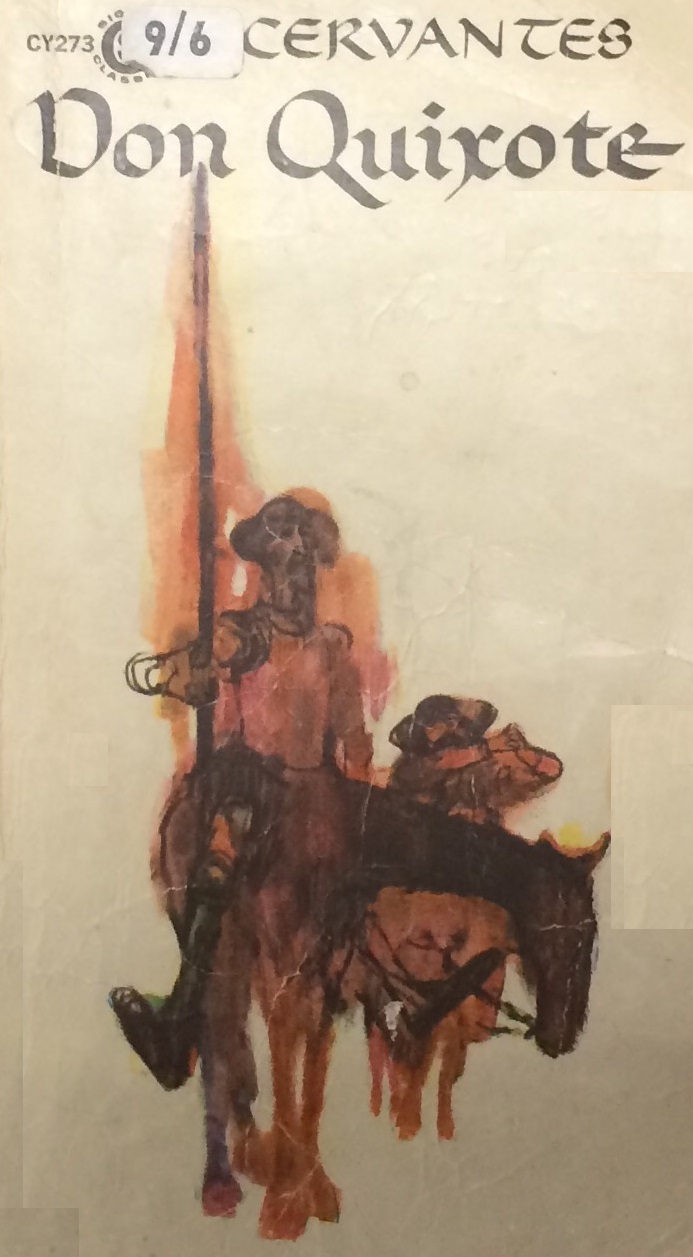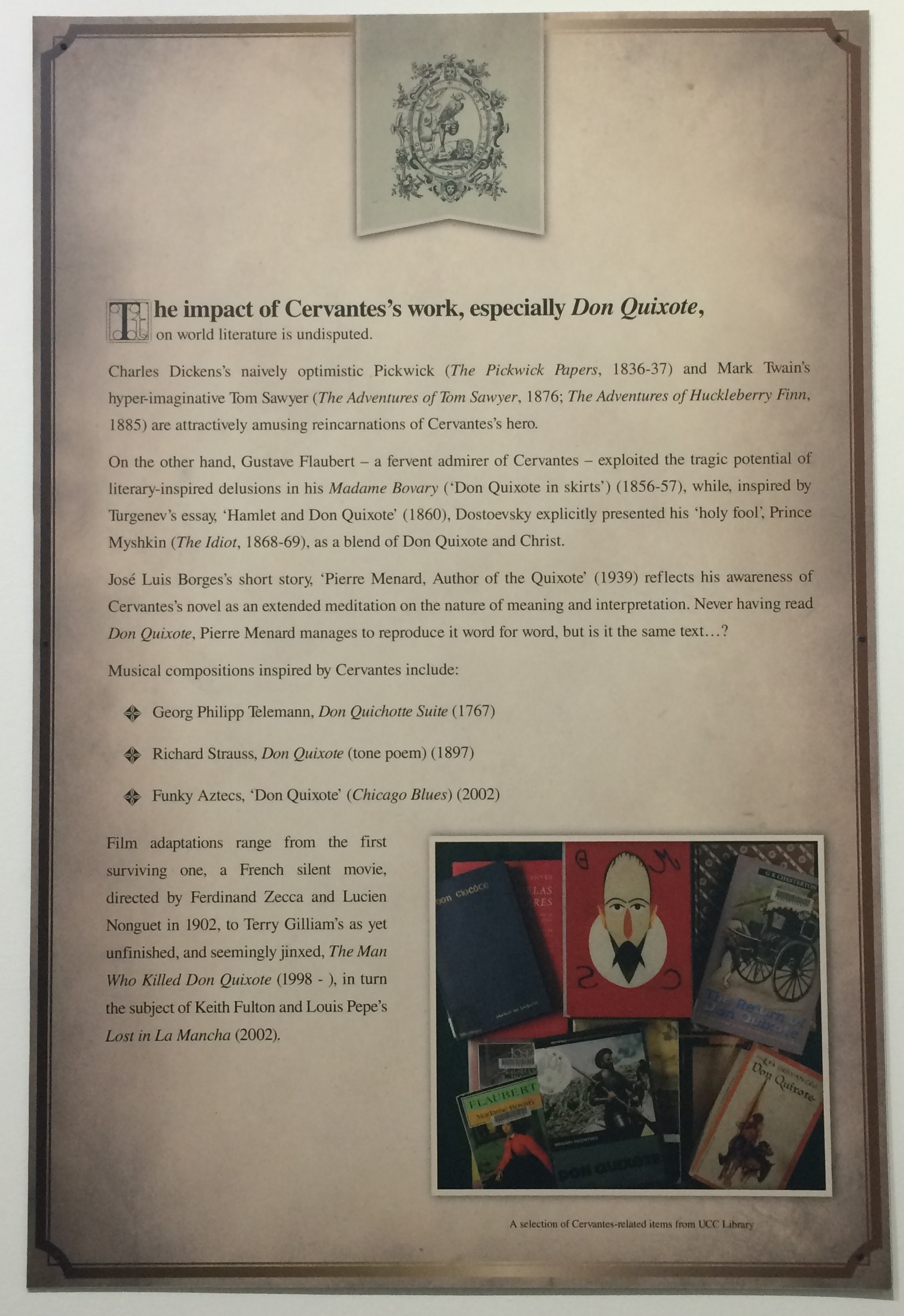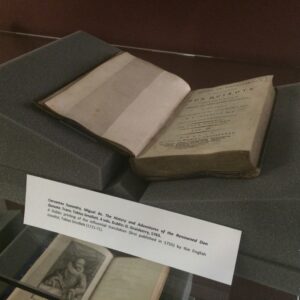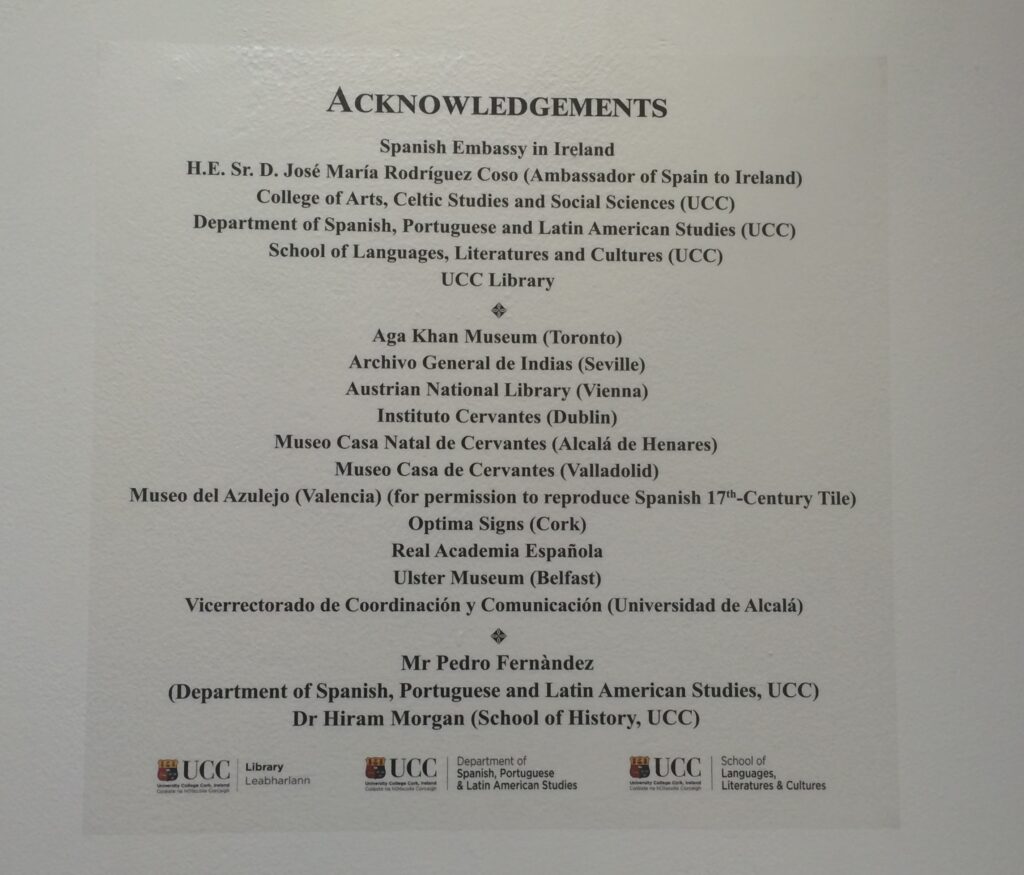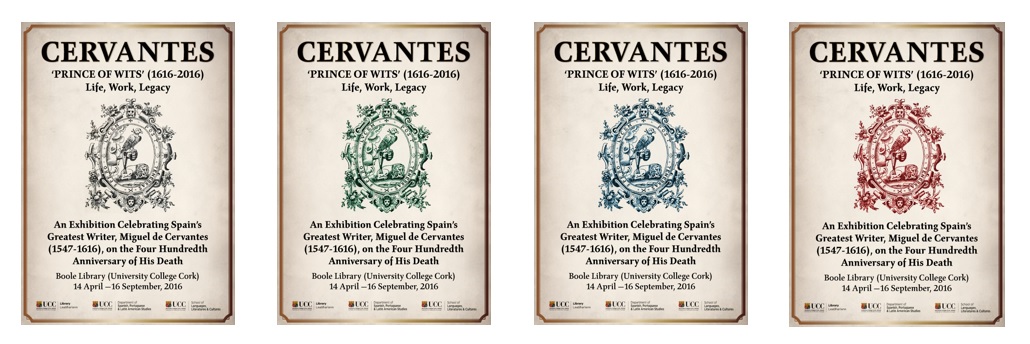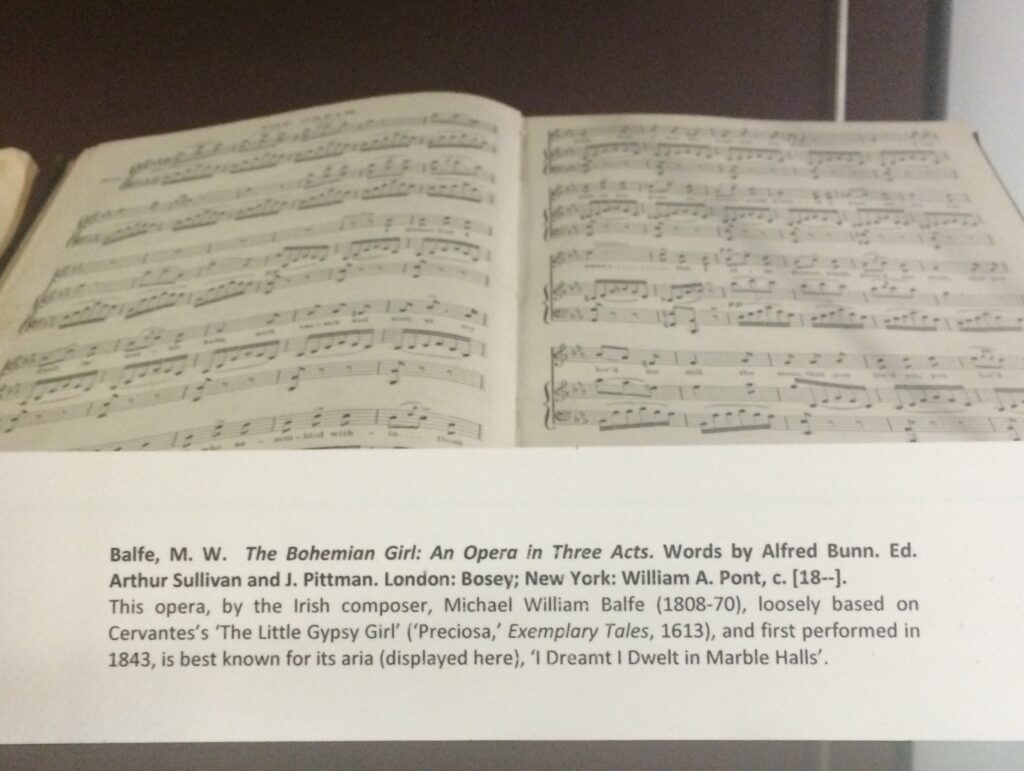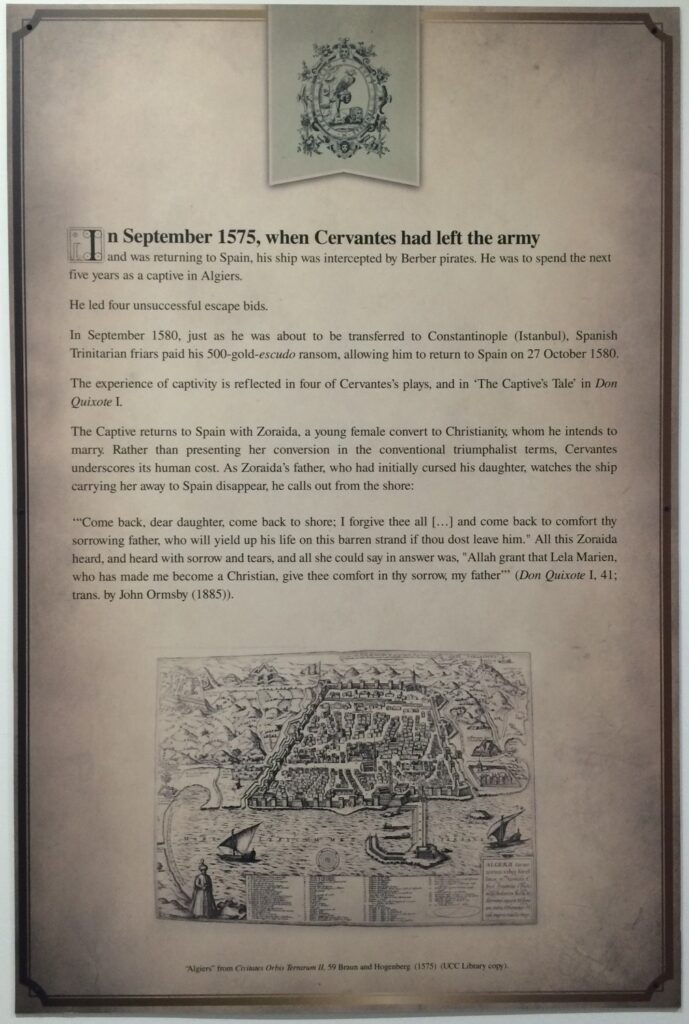Curating ‘Cervantes “Prince of Wits” (1616-2016): Life, Work Legacy’
- Elaine Harrington
- September 13, 2016
The River-side welcomes this guest post from Dr Stephen Boyd, Department of Spanish, Portuguese and Latin American Studies on his experience curating the exhibition Cervantes “Prince of Wits” (1616-2016): Life, Work Legacy.’
I hope that this post which recounts and reflects on the experience of preparing the ‘Cervantes “Prince of Wits” (1616 – 2016): Life, Work, Legacy‘ exhibition, currently running (until 16 September 2016) in UCC Library, might help to inspire and orientate others considering creating something similar.
As the exhibition space is reserved up to two years in advance there are a number of stages to consider before proposing and designing an exhibition:
- Exhibition proposal (2 months)
- Scheduling & planning (2 months)
- Material selection (3 months)
- Collating material and images and drafting text (9 months)
- Design (2 – 3 months)
- Printing & Mounting (1 month)
- Budget (affects the entire timeframe)
Most library exhibitions require a 12 – 18 months’ planning schedule and the time given for each stage is an indication of how long the activity may take. In our case, some activities overlapped with others, for example, design began mid-way through the process and continued until the storyboards were ready to go to print.
The exhibition ‘Cervantes “Prince of Wits” (1616 – 2016): Life, Work, Legacy‘ was completed from initial proposal to delivery in a very tight turn-around (November 2015 – April 2016). This six months’ turn-around was the tightest of margins for delivery of an exhibition; an exhibition cannot be delivered in a shorter time-frame. The short turn around had significant implications for the exhibition team in terms of project deadlines and for the type of design chosen. It also had a significant impact on the images that could be acquired from external sources due to copyright permissions.
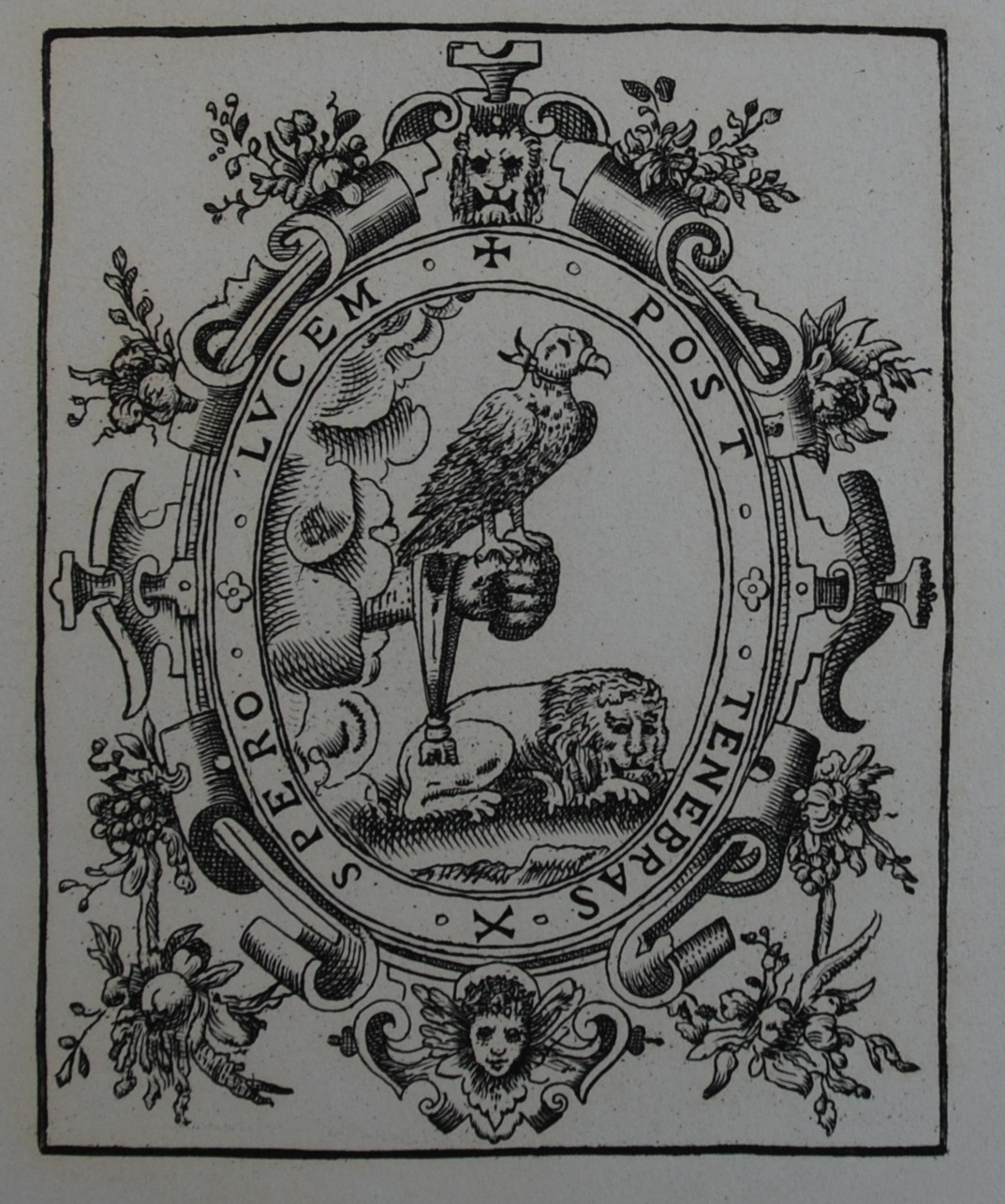
Exhibition Proposal
The idea of mounting an exhibition to commemorate the 400th anniversary of Cervantes’s death (22 April 1616) grew out of a lunchtime conversation with the Spanish Ambassador, H.E. José María Rodríguez Coso, during his visit to Cork and UCC in November 2015. This was a principle reason why he was subsequently invited to open it (14 April 2016). Once UCC Library had agreed, in principle, to host the exhibition, there followed a series of meetings with Crónán Ó Doibhlin (Head of Research Collections and Communications, UCC Library) and Elaine Harrington (Assistant Librarian, Special Collections).
Scheduling and Planning
The issues addressed between Crónán, Elaine and me in initial meetings in November 2016 were generic ones:
- Provisional timeline from initial meeting to opening of the exhibition
- Possible dates (there was a last-minute cancellation for April – October 2016)
- Budget (extremely important as it had implications for the number of images that could be acquired!)
- Location of the exhibition within the library
- Format (a combination of a series of storyboards and material selected from the Library’s collections to be exhibited in display cases)
- Possible layouts of storyboards and display cases
- Basic principles of exhibition design: e.g. the importance of visual attractiveness, of a consistent ‘look’ based on thematic visual elements, and of a layout that would attract and sustain the interest of non-specialist viewers of varying ages.
Crónán and Elaine described previous exhibitions which focused on comparable material and allowed me to see storyboards from one of these. This was very helpful, since it allowed me to form a clear idea of their actual size and of potential designs and formatting. One of the very first meetings was attended by Brian Carty, Director of Optima Signs (Little Island), who has manufactured and installed storyboards for previous exhibitions in the Library. He advised about materials, design possibilities, word limits per storyboard, and about the production schedule and deadlines.
I should note that throughout the entire process, all involved in putting together the exhibition had access to a shared folder.
Selection of Materials
The first step involved using the Library catalogue to draw up an inventory of all of its holdings of Cervantes’s works, of translations of each of them into the major European languages (including Irish), and of novels, stories, plays, films, works of art and musical scores inspired by them.
The second step involved creating a shorter version of that list, consisting of the earliest and / or most significant editions, translations and derivative works. Elaine then located all the books on this shortlist and arranged them in the Rare Books Reading Room in Special Collections. This was in order to make a final selection for display in exhibition cases according to the criteria that she sets out in the first post and so that potential images and texts for reproduction on the storyboards could be identified. It was a great pleasure for me to see, for the first time, the full range of fine editions of Cervantes (especially of Don Quixote), many going back to the eighteenth century and forming part of the Cooke Collection, held by the Library, as it was also to discover and read some of the interesting marginal notes made by Seán Ó Ríordáin in his modest paperback edition of Don Quixote, and the letter of 23 July 1929 (reproduced and described in detail in the first post) from David Garnett to William Cooke discussing the relative merits of some of the most influential translations of Cervantes’s great novel.
Collating Material: Storyboard Texts
The subject of Cervantes’s life, work and influence is a vast one. Trying to do some kind of justice to it in just fourteen storyboards was challenging. Having decided to sequence the storyboards so that they would cover (fundamentally chronologically):
- historical context (Golden Age Spain)
- Cervantes’s life and works
- his wider cultural influence (especially in England, and including on Shakespeare) and legacy
- references to and connections with Ireland
The next steps were to decide what the theme or sub-theme of each storyboard would be, and – most challenging of all – to decide what information and which ideas were really essential in each case, and how they could most effectively be conveyed within the confines of the suggested 200 words of text allowed for each board.
Collating Material: Storyboard Images
Perhaps even more challenging and time consuming than drafting the storyboard texts was the process of selecting and acquiring suitable images. Identifying what images are required should start as early as possible within the exhibition process as the time needed to complete an institution’s reprographic process can vary widely. In practice three months is required to agree the copyright clearance, the format of the chosen image and how it can be used, and the necessary fees. Images are generally only supplied after payment is received.
The images were of two kinds: those sourced from the Library’s holdings and those sourced externally. In the former case, the selection depended on the relevance, visual attractiveness, quality, and therefore suitability for reproduction, of the originals. In the latter case, the same criteria applied, but the fundamental constraint was budgetary and as the acquisition process began later what images could be delivered in time. I began by using the internet to put together an extensive ‘wish-list’ file of paintings, drawings, engravings, frontispieces, maps, archival documents, and photographs of buildings and artefacts from which to make a final selection.
In relation to UCC Library’s Special Collections’ material photography and editing of the required images took approximately 20 hours spread over a number of days. Some suggested images had to be discarded as after the photo was taken significant bleed-through from text on the other side was noticed. When tight bindings are photographed a curve can appear on the image. When the image is blown up the inevitable distortion is too great. The outcome is similar if the original book printing process placed a curve on the page. In these cases the photographed images are discarded. Each item was photographed under strict archival conditions so no book was harmed in the making of the photos!
The following are some observations about sourcing images from institutions external to UCC which I hope might be helpful. How to go about accessing information on terms, conditions and costs for reproduction is made clearer on some institutional web sites than on others. Most institutions require completion of a reprographics request form although in some cases (mostly Spanish, I regret to say!) the process is rather more complex and bureaucratic. Typically, a reprographics request form asks for more or less detailed information about:
- the precise intended use of the image
- the size at which it will be reproduced
- the number of times that it will be reproduced
- in the case of an exhibition, the entry cost (if any)
- duration of the exhibition.
Most, but not all, institutions offer a discounted rate when images are reproduced for educational / non-profit purposes, but, even so, the fees charged can vary quite widely. In the case of the images for the Cervantes exhibition, the fees charged ranged between €45 and €200, and could have been higher had our budget permitted. The fee of €200 allowed for reprographic reproduction twice (i.e. on one wall and on a storyboard) but not for use on social media or on a brochure. That would have required an additional fee for each use.
The response rate to enquiries also varies greatly from institution to institution. Generally, I found archival institutions to be (quite dramatically) slower in replying to queries and in processing reprographics’ request forms. All institutions required an appropriate and / or specifically worded acknowledgement to accompany reproduced images. Some institutions which did not charge a fee for supplying images of their own premises or artefacts make them available on condition that photographs of the relevant exhibition panels in situ were sent to them for their records.
Drafting Text and Design
At a very early stage, Brian Carty (Optima Signs) sent previews of design alternatives, based on previously agreed images, texts and decorative elements, for the large external wall panel. A short while later, on the basis of draft texts and selected images for the first few storyboards, he prepared a series of design format proposals, and invited Elaine and me to view them on-screen in his in business in Little Island. We were able to select our preferred format (background colour; fonts; decorative elements etc.) and then, through a process of discussion, see the details and relative dimensions being refined on-screen, as well as deciding on the precise way in which the Spanish tile design we had selected for this purpose would function as a link between the storyboards. Finally, at a later stage, Brian sent us a PDF file of complete drafts of all the storyboards, of the internal title panel, two additional, non-narrative panels (featuring Cervantes’s family tree and an image of Don Quixote), and of a list of acknowledgements, for editing.
In relation to the display cases located within the exhibition space, captions for the material in these cases also had to be written. A word limit on the caption means that the content should be more accessible and does not distract from the object. A brief 50 word synopsis was written for each item describing its relevance. Fortunately, the captions were printed in-house by the Library and so were not under the same time constraints as the storyboards’ material.
For each item placed into the display cases suitable mounts had be found dependent on which page was to be shown and where the item would be located within the case. For example a page of text which needed to be read didn’t work as well on an upper shelf of an exhibition case as it might not be seen.
Budget
After each exhibition and once the previous material has been removed the exhibition space is painted. A budget for the exhibition is agreed between the Library and the proposing department, with the specification of the design subject to budget constraints. The Library expects costs to be shared equally between the Library and the exhibition proposer. In additional Library staff and material costs are significant. Yet in reality each exhibition is produced on a shoe-string budget in comparison to other institutions.
Printing and Mounting
A week minimum is required to print the storyboards and vinyl text for the exhibition title. Another week is required for the fitters to hang the storyboards and place the vinyl text on the exhibition walls. Vinyl may vary from text of the exhibition titles to a tile border.
Endnote
I found creating an exhibition to be a time-consuming and demanding process, but also a very enjoyable and gratifying one through which I learned a great deal about the technicalities involved and about the extent and quality of the Library’s holdings. It was a particular pleasure, on the day of installation, finally to see what had previously existed only on paper and on screen gradually emerging in large-scale physical form. I would like to end by saying a word of sincere thanks to Crónán and Elaine for their professionalism, and invaluable help and advice. It was a great pleasure to work with them.
